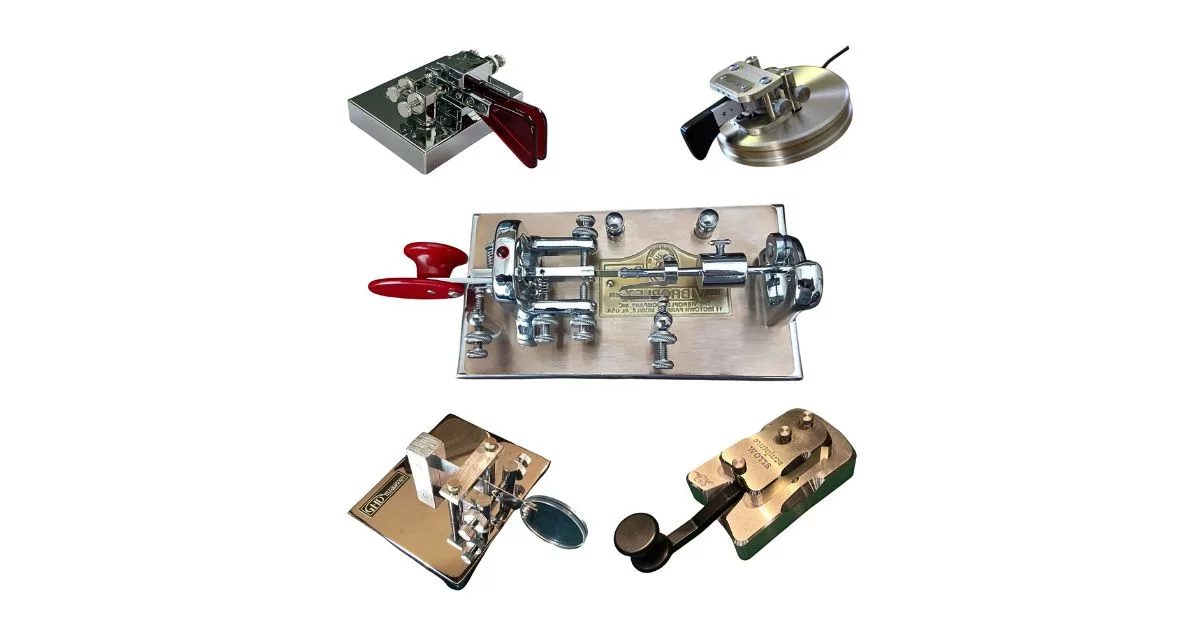Introduction to the many different CW paddles available today, one will fit every operator’s style and skill level. Try one or all of them to find your favorite. The Morse code came to life when a gentleman by the name of Samuel Morse invented it on May 24th, 1844. It found its start with the telegraph as it proved quicker than the pony express for delivering messages. Later use was in amateur radio and the military.
Morse code is a series of dots and dashes that represent letters, numbers, and special characters for the purpose of sending messages back and forth. The speed at which a person can send words determines their skill level. Speeds of fifteen to thirty words per minute is today’s average. High speed operators can converse or do contests at thirty to sixty words per minute. The speed record is somewhere around 75 words per minute.
Different CW Paddles

Straight Key
The Straight Key is the simplest to use, but takes the most practice to learn. You need to learn the spacing of the dits, dahs, and spacing between letters and words. A dah is three times the length of a dit; furthermore, spacing between words is three times as long as spacing between letters. A downward push keys the transmitter to form the tones.
The character and spacing length will need to change with any speed adjustments by the operator. The timing is very important so a letter like “C” does not sound like two smaller letters. There are straight key contests and the speed is usually at or under 20 words per minute for this type of key.
 Single Lever Paddle
Single Lever Paddle
The single lever paddle is usually called a side swiper or cootie key. It is similar to the straight key, but has a side-to-side motion for keying the transmitter. This is one of the most difficult to learn if you already learned on other paddle/keys.
The side-to-side action does not have a dit and dah side. You make the dits and dahs manually using both paddles. For example, to send an O, it would be a dah to one side, then the other side, and back to the first side. An O is three dahs, but you have to time the dahs and spacing between them correctly.
Single Lever Iambic Paddle
The single-lever iambic paddle has one lever that will swing side to side, each with a contact point. One side will form the dits, and the other side will form the dahs. Paddles with iambic sending require an electronic keyer. Most modern radios have built in keyers.
The operator controls the spacing between characters and words. It requires several back and forth movements for particular characters like C, F, and L, along with punctuations and prosigns.
Morse Code Characters
The Morse code alphabet includes the twenty six letters, numbers from 1 - 0, and most punctuations. Prosigns are two-letter combinations that have specific meanings, Q-codes, and a large variety of abbreviations.
Once a person learns the letters and numbers, the prosigns and Q-codes will be easy. The chart below shows the Morse code characters.


Dual Lever Iambic paddle
The dual lever iambic paddle has two levers that work independently: one for the dits, and the other for the dahs. The left paddle will make the dits. The right paddle will do the same for the dahs.
Left handed operators simply reverse the paddles. A squeeze of both paddles makes for far less movements when sending combination letters like C, F, L and punctuations. Just depress the one that starts the character first and hold until the last dit or dahs starts.

Semi Automatic Bug
The semi automatic bug is unique, it is a combination of a side swiper and manually-made iambic action by the bug. Pressing and holding the left paddle will send a string of dits. A movable weight will change the speed of the dits. The operator make the dahs and spacing while matching the dah speed to the dits.
This allows the operator to have their own style that can be recognized by other operators that know them. This type of paddle is precise, expensive, and can be considered a work of art. Left handed versions can be made when purchased new.
 Bencher or MFJ Iambic Paddle
Bencher or MFJ Iambic Paddle
The Bencher and MFJ line of paddles are a low cost alternative that makes a great starter key. I learned Morse code on this paddle. I still use it today for field work like POTA and field day stations.
The construction starts with a heavy steel base and four non skid feet. They come in black or chrome, but a gold finish is optional. The paddle workings are steel with a chrome finish, and have clear polished Lucite paddles. The spring had adjustable tension, and the contact spacing is also adjustable to satisfy all operators.
This is a great paddle, and will last a lifetime if taken care of correctly.
